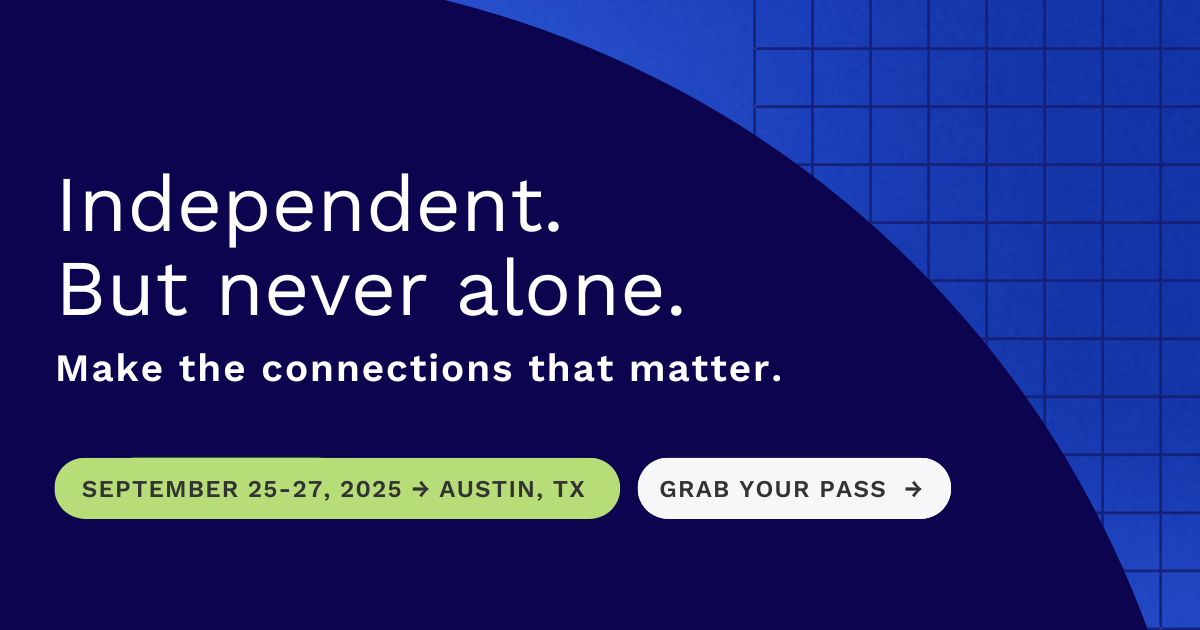How to Form a Partnership as a Financial Advisor
Share this
Many independent firm owners strike out on their own with the assumption that no one else does what they want to do. Perhaps they’ve been siloed in the sales and commission world for so long that they think they're the only person interested in providing real, client-focused financial planning. I hear this time and time again during conversations with XYPN members.
However, as those advisors start to branch out and meet other fee-for-service advisors like them through communities like XYPN or NAPFA, they realize there are many others who share the same values and take the same holistic approach to financial planning. As they dive into this world and connect with like-minded people, they begin to question if they really want to continue to go it alone, or if they might be interested in finding a business partner. In this blog, I’ll explore the reasons why the latter might be the right choice for you.
Why Seek A Partner?
Being a solopreneur offers many benefits; chief among them is control. You’re in the driver’s seat so you get to develop your own client persona(s), decide how to set, and when to raise, your fees, and manage your brand and messaging. There’s no waiting for a compliance department to approve the email you wanted to send to clients three weeks ago. You get to design your ideal schedule; if you want to work 20 hours/week or 60 hours/week you can. Need to leave early to catch your kid’s soccer game? Done. Want to take a three-day weekend every week this summer? Done and done!
Being a solopreneur also has some drawbacks. You wear all the hats. You’re responsible for everything from compliance to sales to the actual financial planning. It’s difficult to switch off at the end of the day or when you’re on vacation. You can set an away message on your email and turn off your phone, but ultimately, the buck stops with you. I spoke with one solopreneur who told me that in five years she had never taken a “real” vacation.
Being a solopreneur also gets plain lonely sometimes. There’s no one around to bounce ideas off of or hold you accountable for your schedule and goals. You are your own boss and employee. There are, of course, different avenues of support you can tap into: finding a mentor, working with a coach, engaging in a mastermind group. But if you want to take it one step further, you might find that forming a partnership is right for you.
Partnering allows you to accelerate your firm’s growth by leaning into the idea of strength in numbers. Once you’ve partnered, you can take off some of those hats that you no longer want to wear. This gives you the capacity to concentrate on what you’re good at and what you actually like to do. Growth accelerates once you become part of a team. It creates an ideal scenario for retargeting any clients you might have passed on due to time constraints, or who might have passed on you due to a lack of specific expertise. Having a second, especially in the world of financial planning, gives clients the peace of mind that should anything unexpected happen, you have support. And if something unexpected should happen to you, clients need not worry because they know your business partner will be just as familiar with their situation as you were and will be able to seamlessly access their accounts and information.
Joining forces with a partner can also free up your time to dive into some of your other passions. For Arielle Minicozzi of Modern Money Advisor, a partnership fell into her lap.
“I wasn't specifically looking for a business partner, but when my other business began to grow faster than expected, it seemed like the perfect opportunity. It allowed me to focus on my other business while continuing to serve my financial planning clients more efficiently and holistically than I could on my own.”
If you’re like Arielle, partnering could allow you to launch that podcast you’ve been thinking about or accept more speaking engagements without compromising the quality of service your clients deserve.
Understand Yourself First
Before you start searching for your ideal partner, you need to understand yourself. Take some time to do some self-reflection. Sit down and list your strengths, weaknesses, likes, and dislikes—then work on finding someone with complementary opposites. The key is to make sure you share the same values so you don’t set yourself up for unnecessary conflict. Each of us brings our individual experience and background knowledge to the table, but you need to get clear on what you bring to the table, and areas where you may be lacking, before seeking out a partner. You shouldn’t not seek out a partner who shares the same strengths and shortcomings as you; you want someone who shines where you don’t. Sit down and think about what you love to do, what you’re good at, what you hate to do, and what you’re bad at. Here are some questions that will help get you started:
-
What skills have helped you thrive in school and at work?
-
Which tasks invigorate you at work? Which tasks drain your energy?
-
Whom in this industry do you admire? Why?
-
How do you spend your time outside of work?
Beyond figuring out the mechanics of what you bring to a working relationship, one of the biggest challenges in merging is checking your ego at the door. You’ve already put a lot of blood, sweat, and tears into building your own firm. Think about whether or not you’re ready to share that and potentially let it evolve into something bigger. You need to be ready to have emotionally charged conversations with potential partners. Learn from the people who have gone before you. Kerrie Beene shares how being a solo advisor was “draining” and “causing a lot of stress” before she joined forces with the rest of the Rooted Planning Group. In this episode of XYPN Radio, she and her team open up about the rollercoaster of emotions and experiences they went through together that ultimately made them a better, stronger practice.
The “Dating” Process
Once you’ve decided that finding a partner is the right next step for you and your business, you enter the “dating” phase. Now you might think that’s a weird way to phrase seeking out a business partner, but dating is exactly how many advisors I’ve spoken to refer to this part because it’s a lot like finding a romantic partner—a lot of open and honest conversations about the future (without the long walks on the beach).
Once you’ve figured out where your strengths and passions lie, you can seek out someone who complements you. “Figuring out ‘who’ to merge with really comes down to finding someone that isn't like you,” shares Trevore Meyer of Financial Design Studio. “They [need to] have different strengths than you but share enough core values to know that building something together is better than going it alone.” Trevore and his three partners joined forces in 2019 after several months of courtship. They dive deep into what that process was like in their interview on #XYPNRadio.
When it comes to finding “the one”, you need to put yourself out there. There’s no partnering app for financial advisors (yet!). Attend networking events, don’t be afraid to tap your community, and put yourself out there as someone who is open to partnering. Be transparent with people about your struggles and your passions and your goals for the future. The more you put yourself out there, the more opportunities come your way. Arielle, who met her business partner, Angela, through networking, shares, “[Angela] and I were part of the same XYPN launchers group and from day one I admired her values and drive.”
And of course, Michael Kitces has something to say about forming a partnership:
“In practice, I find that most advisors seem to find partners from their existing personal and professional networks – most commonly fellow advisors from their existing platform (e.g., at their current custodian or broker-dealer), or via a shared group affiliation (e.g., fellow advisors from the Financial Planning Association or NAPFA). Anecdotally, I find that most partnerships come about from advisors who have “known each other for years” and ultimately decided to either merge their practices, or form a new business together, because there was finally an alignment of goals and interests at a time that was mutually beneficial for both to pursue the effort.”
You Think You’ve Found “The One”
Now that you think you’ve found “the one,” the real work is about to begin. XYPN Executive Business Coach, Arlene Moss shares this advice: “Don’t make assumptions about your potential partner. You might think that someone who is a CPA will handle all the bookkeeping and any tax related questions. But they might have gotten into the RIA game to get away from taxes!” The point here is don't pigeonhole someone based on what you see on the surface.
It’s a good idea to have a conversation with a neutral third party present. It can be worth the investment to hire a business coach or business therapist to facilitate conversations in a safe space. Having an objective person present will allow you to talk through important questions and get you on the same page. Start with your deal-breakers and any non-negotiables. “Rushing into anything just because the idea of a larger firm seems appealing is a recipe for disaster in my book,” says Trevore. Some good questions to ask each other include:
-
What are your short-, mid-, and long-term goals?
-
How will you assign new clients?
-
How will you share expenses?
-
Are you both on the same page about how many hours you’ll each work and taking time off?
-
What is your exit strategy if the partnership doesn’t last?
Do some reading and research together. I recommend Buying, Selling, & Valuing Financial Practices by David Grau Sr. of FP Transitions. This book helps buyers and sellers and merger partners address each of their needs, issues, and concerns. Many advisors also hire FP Transitions to value each of their respective firms if a potential merger is in the works. I also recommend “The Partnership Charter,” in which author David Gage offers a comprehensive guide to the art of establishing and maintaining a business partnership. The Partnership Resource uses mediation and facilitation skills to help people build and sustain exceptional business partnerships. Co-founder Tanya Rapacz talks about formalizing partnership decisions on an episode of #FASuccess with Michael Kitces.
Taking a personality test together is another way to make sure you’re on the same page, both in terms of personality and what you bring to the table. Doing this together can be an incredibly useful tool as you explore what your future relationship would look like and what you both bring to the table. Arlene outlines several different types of personality assessments out there in this blog, in which she writes:
“Personality test activities lead to improved understanding among your team members. Knowing more about who everyone is, what they do best, and what their weaknesses are creates room for more grace in professional interactions or workplace conflict, and allows for deeper connections to be made. That means more productivity, and more positive workplace interactions.”
Think about how you want to work with your team moving forward. For Kerrie, the decision to join a larger team was a no-brainer, despite the distance. While most of the team is based in upstate New York, Kerrie resides with her family in Oklahoma. They stay in touch via Slack and Zoom throughout the week and text each other regularly. At least twice a year they meet in person; once for XYPN's annual conference and once for an in-person team retreat. Especially for virtual partners and teams, retreats give you a chance to connect outside of your day-to-day work environment and take time to truly understand one another, as well as each person’s role within the grand scheme of your business. This connection helps you to align your team’s goals, boost morale, and ultimately improve productivity at work when your team returns with renewed inspiration and energy.
Make It “Official”
Once you’ve decided to make it official, it’s time to talk to a lawyer and a compliance consultant. For Arielle and Angela, the biggest hurdle they faced was the time and effort spent drawing up the legal documentation and updating the compliance documents. It’s important to have everything written down because while you don’t want to think of your partnership going south, it’s important to protect yourself and your clients for any possibilities.
You’ll also need to button up your marketing and branding. You need to think about whether you’re keeping one person’s brand or rebranding entirely upon partnering. “It was also a clear choice to keep the Modern Money brand, as Angela had spent a good amount of time and resources cultivating the brand image, attracting ideal clients, and marketing the business, though other advisors might choose to dissolve both existing brands and create a new joint venture,” says Arielle. New pictures will need to be taken for the website and don’t forget to craft a press release announcing the news.
From the time you decide that partnership is the path that you want to pursue, it can take months or even years before it comes to fruition. Approach the process with an open mind, a list of non-negotiable deal-breakers, and the confidence to walk away if it’s not right for you.
In closing, I’ll leave you with one last piece of advice from Arielle: “Partnership is like marriage—you should only get involved with someone you want to be with for the long haul and who you trust has your back through the ups and downs that life (and business) throw your way.”
 About the Author
About the Author
As a Lead Member Experience Specialist at XYPN, Isabel connects members to the most valuable resources and benefits relevant to them and their business. She specializes in working with members in the Scaling phase, which gives her unique insight into what kind of growth and pain points that experienced advisors go through. Isabel believes that being a lifelong learner lays a strong foundation for successful entrepreneurship.
Share this
- Fee-only advisor (381)
- Advice (305)
- Business Development (248)
- Independent Financial Advisor (203)
- Growing Your Firm (161)
- Marketing (133)
- Financial Planning (129)
- What Would Arlene Say (WWAS) (81)
- Business Coach (80)
- Firm Ownership (78)
- Training (75)
- Compliance (72)
- Business (69)
- Building Your Firm (65)
- Financial Advisors (63)
- Online Marketing (61)
- Events (59)
- Starting a Firm (52)
- Staffing & HR (49)
- Technology (49)
- From XYPN Members (48)
- Launching a firm (46)
- Advisors (41)
- Entrepreneurship (38)
- Taxes (37)
- Networking & Community (33)
- Interviews and Case Studies (32)
- Investment Management (31)
- Sales (27)
- Social Responsibility (27)
- Tax Preparation (27)
- XYPN Invest (26)
- Business Owner (25)
- Small Business Owner (20)
- Financial Management & Investment (19)
- Industry Trends & Insights (19)
- Financial Education (17)
- Financial Planners (17)
- Independent Financial Planner (17)
- Tech Stack (17)
- XYPN (17)
- Leadership & Vision (16)
- Investing (15)
- Niche (15)
- How to be a Financial Advisor (14)
- NextGen (14)
- RIA (14)
- Media (13)
- Preparing to Launch (13)
- Press Mentions (13)
- RIA Operations (12)
- RIA Owner (12)
- XYPN Membership (12)
- Assets Under Management (AUM) (11)
- First Year (11)
- Goals (11)
- Scaling (10)
- Advisor Success (9)
- Building Your Firm (8)
- Communication (8)
- Lessons (8)
- Study Group (8)
- Time Management (8)
- Virtual Advisor (8)
- Behavioral Finance (7)
- Growth (7)
- Pricing Models (7)
- From Our Advisors (6)
- Independent RIA (6)
- Money Management (6)
- Motivation (6)
- Processes (6)
- Automation (5)
- Broker-Dealers (5)
- College Planning (5)
- Filing Status (5)
- How I Did It series (5)
- Investment Planner (5)
- Mental Health (5)
- Michael Kitces (5)
- Preparing to Launch (5)
- RIA Operations (5)
- Retirement (5)
- Risk and Investing (5)
- S Corpration (5)
- Support System (5)
- TAMP (5)
- Wealth (5)
- Year-End (5)
- Client Services (4)
- Outsourcing (4)
- Selling a Firm (4)
- Succession Plans (4)
- Benchmarking Study (3)
- Budgeting (3)
- Career Changers (3)
- Engagement (3)
- Fiduciary (3)
- Getting Leads (3)
- Membership (3)
- Millennials (3)
- Monthly Retainer Model (3)
- Partnership (3)
- Pricing (3)
- Recordkeeping (3)
- Risk Assessment (3)
- Small Business (3)
- Staying Relevant (3)
- Work Life Balance (3)
- Advice-Only Planning (2)
- Bookkeeping (2)
- Charitable Donations (2)
- Client Acquisition (2)
- Differentiation (2)
- Health Care (2)
- IRA (2)
- Inflation (2)
- Productivity (2)
- Implementing (1)
Subscribe by email
You May Also Like
These Related Stories

Advice for Independent Financial Advisors, From Advisors

Embracing the Abundance Mentality When Building An Advisory Firm





